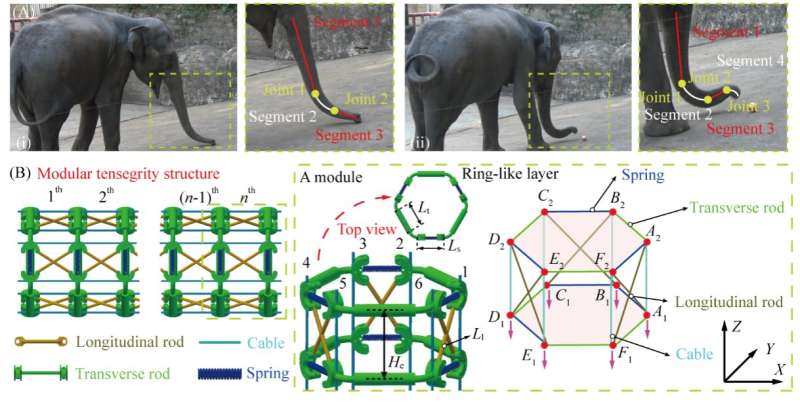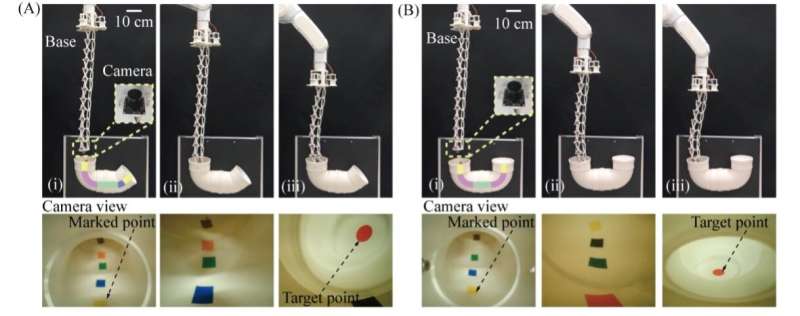January 26, 2023 feature
This article has been reviewed according to Science X's editorial process and policies. Editors have highlighted the following attributes while ensuring the content's credibility:
fact-checked
trusted source
proofread
A continuum robot inspired by elephant trunks

Conventional robots based on separate joints do not always perform well in complex real-world tasks, particularly those that involve the dexterous manipulation of objects. Some roboticists have thus been trying to devise continuum robots, robotic platforms characterized by infinite degrees of freedom and no fixed number of joints.
Continuum robots are typically based on cables or other deformable components that can move more freely and are not restricted by fixed joint structures. Despite these advantages, many continuum robot designs proposed still cannot yet efficiently navigate complex and unstructured environments.
Researchers at Sun Yat-Sen University, Dalian University of Technology and London South Bank University have recently developed a new continuum robot inspired by the trunks of elephants. This robot, introduced in a paper published in Soft Robotics, has a customizable design that allows it to be tailored for different applications.
"We discovered that the existing cable-driven continuum robots always demonstrate circle-shaped profiles after deformation, which may hinder their interaction with varying-curvature environments," Jianing Wu, one of the researchers who carried out the study, told Tech Xplore. "To overcome this limitation, we attempted to propose a continuum robotic paradigm for adapting to application scenarios with varying curvatures."
Elephant trunks are naturally divided into finite segments connected by pseudo-joints. This allows elephants to interact with unstructured environments more efficiently, for instance by flexibly squeezing their trunk into narrow spaces or reaching higher branches.
Due to their unique conformation, the stiffness of different segments of elephant trunks can be independently regulated and tuned to bend in different ways. This ultimately allows elephant to adapt the shape of their trunk to tackle different tasks and reach objects with various shapes.

"Inspired by the movements of elephant trunks, we presented a continuum robot with pre-programmable stiffness distribution to solve the robotics problem we were trying to tackle," Haijun Peng, who is another researcher of this study explained. "By regulating the stiffness distribution, our bio-inspired robot not only demonstrates various deformation patterns but also is able to move through pipelines with varying curvatures."
The elephant trunk-inspired robot created by Wu and his colleagues is based on a class-3 tensegrity structure comprised of several elastic elements, which are evenly distributed throughout the structure. This allowed the researchers to program the local stiffness characteristics of the robot simply by replacing elastic elements with others that have different stiffness magnitudes.
"Benefiting from the difference in the stiffness distribution, the continuum robot exhibits varying robotic configurations under an identical actuation criterion," Wu said. "Our bio-inspired continuum robot is able to not only conformally interact with varying-curvature environments but simplify the complexity of the required actuation and control systems by leveraging the inherent intelligence."
The researchers have so far used their design to create a prototype robot consisting of 12 elastic modules. They then showcased its deformation capabilities in a series of trials, focusing on different real-world scenarios.
"Long-term and never-ending evolution has led animals to exhibit amazing capabilities," Wu said. "If we used our full caution to observe them, we might harvest a spectrum of bio-inspired design paradigms for future robotic systems. For example, inspired by the interaction behavior of the elephant trunks, we could present a more flexible continuum robot to satisfy the interaction requirements in varying-curvature environments."
In the future, the continuum robot created by this team of researchers could help to automate more real-world tasks in unstructured environments, which are difficult or impossible to tackle using robots with rigid joint structures. Due to its unique design, the robot can also simultaneously support different functions through the installation of diverse end effectors, such as grippers and sensors.
"We would now like to develop smart strategies for stiffness regulation, by which the ability of continuum robots can be further enhanced in exploring unpredictable scenarios in real time," Wu added. "For instance, some advanced materials will be employed for fabricating the spring elements, such as shape memory alloy (SMA), and dielectric elastomer (DE)."
More information: Jie Zhang et al, A Preprogrammable Continuum Robot Inspired by Elephant Trunk for Dexterous Manipulation, Soft Robotics (2023). DOI: 10.1089/soro.2022.0048
© 2023 Science X Network



















